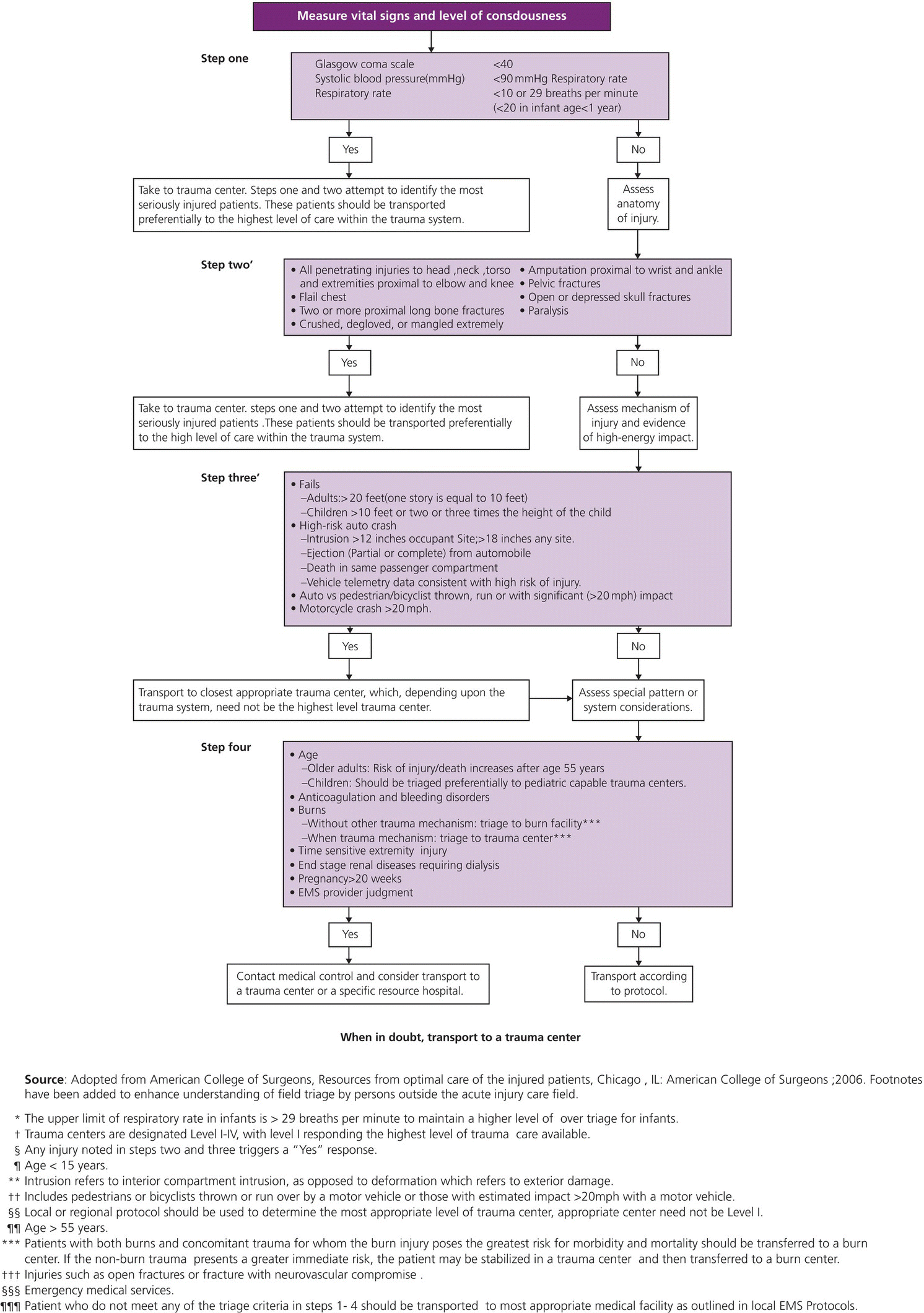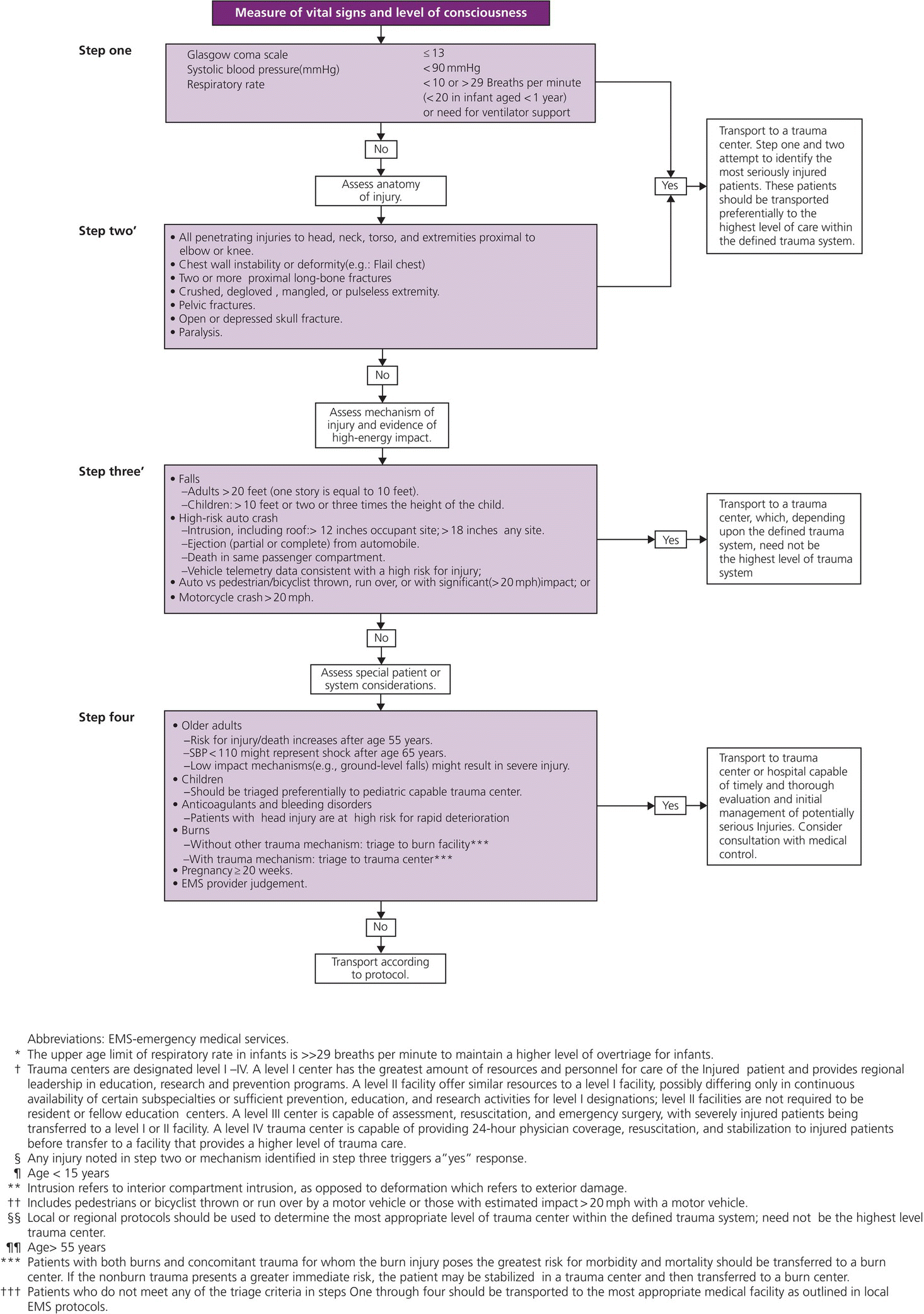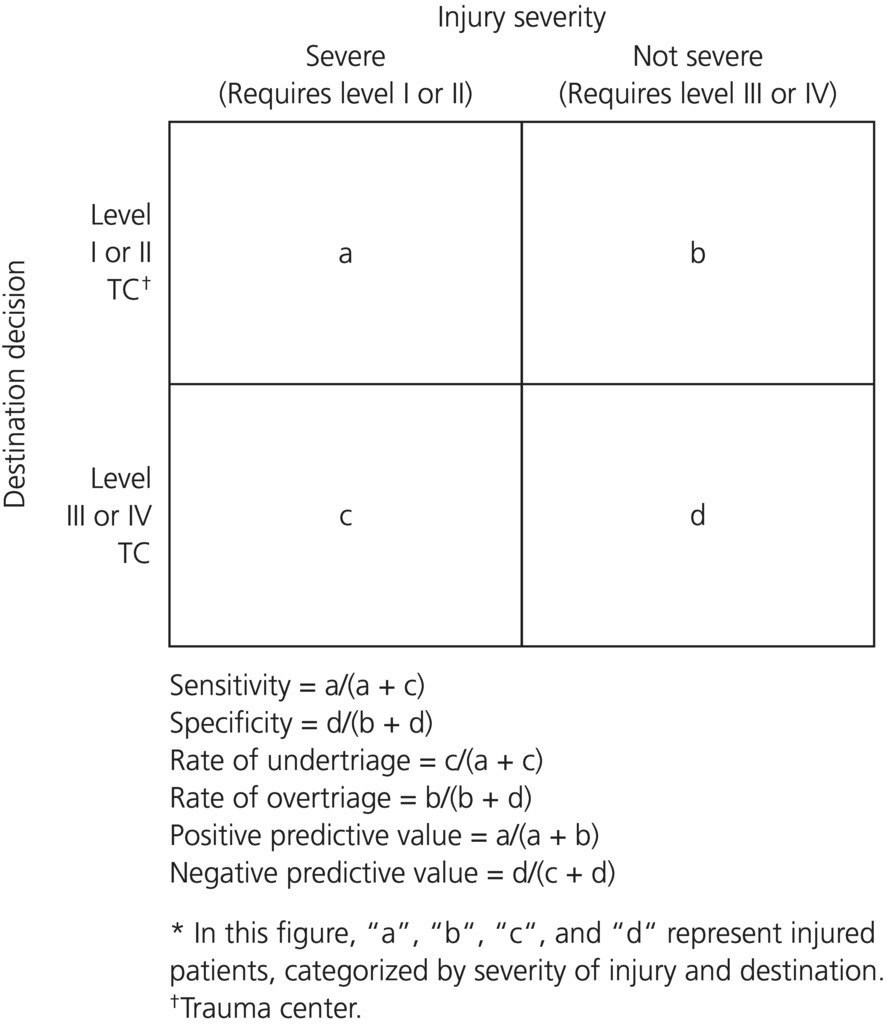Chapter 39 Hiren Patel and Scott M. Sasser This chapter summarizes the National Panel Guidelines for Field Triage of Injured Patients Recommendations of the National Expert Panel on Field Triage, 2011, which has been published previously in Morbidity, Mortality and Weekly Report (MMWR); available at: www.cdc.gov/mmwr/pdf/rr/rr6101.pdf. The text is excerpted from the original publication of current recommendations. In addition, some background materials from an earlier iteration have been included for context; available at: www.cdc.gov/mmwr/PDF/rr/rr5801.pdf. In general, all original MMWR text has been excerpted verbatim with a few exceptions (e.g. edits for transition or conciseness that do not affect meaning or interpretation of the recommendations or existing literature). To subscribe to MMWR, visit www.cdc.gov/MMWR. In the United States, unintentional injury is the leading cause of death for persons aged 1–44 years [1]. In 2008, injuries accounted for approximately 181,226 deaths in the United States [2]. In 2008, approximately 30 million injuries were serious enough to require the injured persons to visit a hospital emergency department (ED); 5.4 million (18%) of these injured patients were transported by EMS [3]. Ensuring that severely injured trauma patients are treated at trauma centers has a profound effect on their survival [4]. Ideally, all persons with severe, life-threatening injuries would be transported to Level I or Level II trauma centers, and all persons with less serious injuries would be transported to lower-level trauma centers or community EDs. However, patient differences, occult injuries, and the complexities of patient assessment in the field can affect triage decisions. The National Study on the Costs and Outcomes of Trauma (NSCOT) identified a 25% reduction in mortality for severely injured adult patients who received care at Level I trauma centers rather than at non-trauma centers [4]. Similarly, a retrospective cohort study of 11,398 severely injured adult patients who survived to hospital admission in Ontario, Canada, indicated that mortality was significantly higher in patients initially undertriaged to non-trauma centers (odds ratio (OR) 1.24; 95% confidence interval (CI) 1.10–1.40) [5]. In 1976, the American College of Surgeons Committee on Trauma (ACS-COT) began publishing resource documents to provide guidance for designation of facilities as trauma centers and appropriate care of acutely injured patients [6–11]. Before this guidance appeared, the typical trauma victim was transported to the nearest hospital, regardless of the capabilities of that hospital, and often with little prehospital intervention [6]. The ACS-COT regularly revised the resource document, which included a decision scheme to provide guidance for the field triage of injured patients. During each revision, the decision scheme was evaluated by a subcommittee of ACS-COT, which analyzed the available literature, considered expert opinion, and developed recommendations regarding additions and deletions to the decision scheme. Final approval of the recommendations rested with the ACS-COT Executive Committee. Following its initial publication in 1986, the decision scheme was updated and revised four times: in 1990, 1993, and 1999 [6]. In 2005, the Centers for Disease Control and Prevention (CDC), with financial support from the National Highway Traffic Safety Administration (NHTSA), collaborated with ACS-COT to convene the initial meetings of the National Expert Panel on Field Triage. The panel comprises persons with expertise in acute injury care, including EMS providers and medical directors, state EMS directors, hospital administrators, adult and pediatric emergency physicians, nurses, adult and pediatric trauma surgeons, persons in the automotive industry, public health personnel, and representatives of federal agencies. During 2005 and 2006, the panel met to revise the decision scheme, and the end-product of that comprehensive revision process (Figure 39.1) was published by ACS-COT in 2006 [11]. In 2009, CDC published a comprehensive review of the revision process and the detailed rationale for the triage criteria underlying the 2006 version of the decisions scheme as the “Guidelines for field triage of injured patients: recommendations of the National Expert Panel On Field Triage” (the guidelines) [12]. Figure 39.1 Field triage decision scheme – United States, 2006. Source: Adapted from American College of Surgeons. Resources for Optimal Care of the Injured Patient. Chicago, IL: American College of Surgeons; 2006. Reproduced with permission of the American College of Surgeons. Footnotes have been added to enhance understanding of field tirage by persons ouside the acute injury care field. In 2011, the panel reconvened to review the guidelines in the context of recently published literature as well as the experience of states and local communities working to implement the guidelines and to make recommendations regarding any changes or modifications to the guidelines. A major outcome of the panel’s meetings was the revision of the guidelines (Figure 39.2). In 2012, CDC published an update to the guidelines, including the rationale for modifications [13]; this update was endorsed by multiple national organizations. Figure 39.2 Guidelines for field triage of injured patients – United States, 2011. Source: Sasser SM. MMWR Recomm Rep 2012;61:1–20. The accuracy of field triage can be thought of as the degree of match between the severity of injury and the level of care. Sensitivity and specificity of screening tests are useful indicators of accuracy (Figure 39.3). Maximally sensitive triage would mean that all patients with injuries appropriate for Level I or Level II trauma centers would be sent to such centers. Maximally specific triage would mean that no patients who could be treated at Level III or Level IV centers or community EDs would be transported to Level I or Level II centers. Triage that succeeded in transporting only patients with high injury severity to Level I or Level II centers would maximize the positive predictive value (PPV) of the process, and triage that succeeded in transporting only patients with low injury severity to Level III, IV, or community EDs would maximize the negative predictive value (NPV). Figure 39.3 Measures of field triage accuracy. Source: Sasser SM. MMWR Recomm Rep 2009;58:1–35. In reality, patient differences, occult injuries, and the complexities of patient assessment in the field preclude perfect accuracy in triage decisions. Inaccurate triage that results in a patient who requires higher-level care not being transported to a Level I or Level II trauma center is termed undertriage. The result of undertriage is that a patient does not receive the specialized trauma care required. Overtriage occurs when a patient who does not require care in a higher-level trauma center nevertheless is transported to such a center, thereby unnecessarily consuming scarce resources. In the triage research literature, all of these measures (sensitivity, specificity, PPV, NPV, undertriage, and overtriage; see Figure 39.3) are used together with measures of association (e.g. odds ratios) to assess the effectiveness of field triage. As with sensitivity and specificity applied to screening tests, reductions in undertriage usually are accompanied by increases in overtriage, and reductions in overtriage are accompanied by increases in undertriage. Because the potential harm associated with undertriage (i.e. causing a patient in need of trauma center care not to receive appropriate care) is high and could result in death or substantial morbidity and disability, trauma systems frequently err on the side of minimizing undertriage rather than minimizing overtriage. Target levels for undertriage rates within a trauma system range from 0% to 5% of patients requiring Level I or Level II trauma center care, depending on the criteria used to determine the undertriage rate (e.g. death and Injury Severity Score (ISS)) [11]. Target levels of overtriage vary (approximate range: 25–50%) [11]. As field triage continues to evolve on the basis of new research findings, overtriage rates might be reduced while maintaining low undertriage rates. Step one of the decision scheme seeks to guide EMS personnel in identifying critically injured patients rapidly through measuring their vital signs and assessing their level of consciousness. The instruction “measure vital signs and level of consciousness” has been included since the 1986 version of the ACS Field Triage Decision Protocol [7]. The sensitivity of physiological criteria to identify severely injured patients has been reported to range from 55.6% to 64.8%, with PPV of 41.8% and specificity of 85.7% [13,14]. A study of 333 patients transported by helicopter to a Level I trauma center during 1993 and 1994 indicated that physiological criteria alone were specific (0.9) but not sensitive (0.6) for identifying ISS >15 [13]. An evaluation of data in the South Carolina EMS registry, conducted to determine undertriage and overtriage rates when EMS personnel used the 1990 version of the ACS field triage guidelines, determined that physiological criteria alone had a sensitivity of 0.65 and PPV of 42% for severe injury (ISS >15) for 753 trauma patients transported to a Level I trauma center in Charleston [14]. Adults meeting such physiological criteria treated at Level I trauma centers had reduced odds of mortality compared with patients treated at lower level trauma centers and non-trauma center hospitals (OR 0.7; 95% CI 0.6–0.9). Multiple peer-reviewed articles published since 2006 continue to support the use of physiological criteria [15–19]. Transport is recommended to a facility that provides the highest level of care within the defined trauma system if any of the following are identified:
Field trauma triage
Disclaimer
Introduction
History of the field triage decision schemes


Accuracy of field triage

Field triage decision scheme recommendations
Step one: physiological criteria
Step two: anatomical criteria

Full access? Get Clinical Tree




